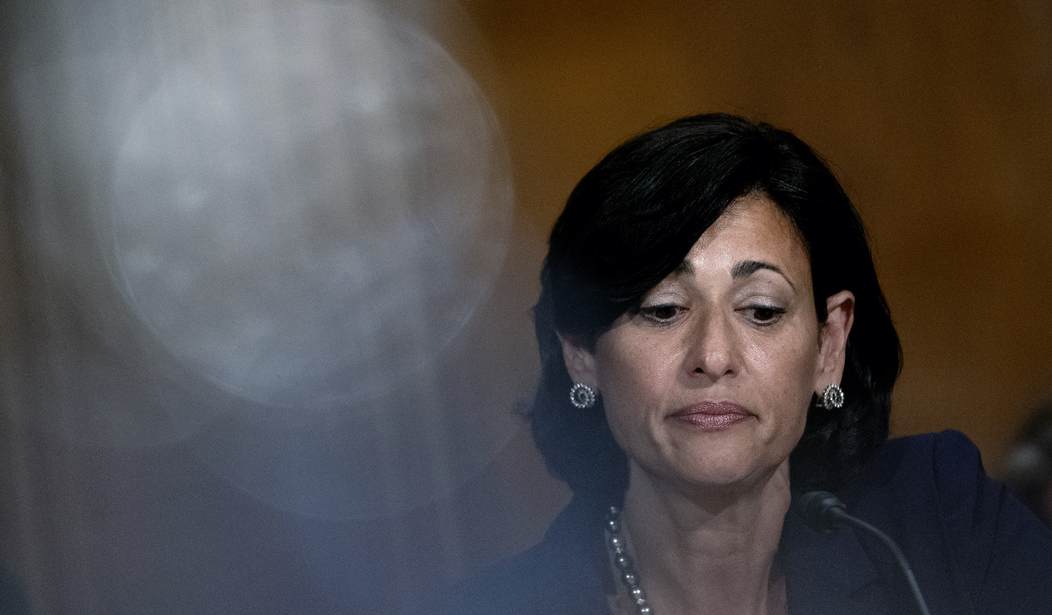As we now know, the Indian study wasn’t the sole basis for the CDC’s conclusion that the vaccinated should start wearing masks again. The Provincetown study plus other research from Wisconsin and Singapore showed that some vaccinated people who ended up with breakthrough infections may have viral loads as high as infected unvaccinated people do, at least for a few days. (The Singapore study found that viral load drops in the vaxxed much more quickly than it does in the unvaxxed, though.)
That suggested that the vaccinated could transmit Delta as easily as the unvaccinated could. But the only study that purported to confirm that transmission was happening among the vaccinated was the study from India.
Which turns out to have been … problematic:
Complicating matters is that when people looked up the India study, a notation said that it had been rejected during peer review. That was quickly changed after [Dan] Crenshaw highlighted that fact in his Twitter thread. Research Square, the preprint site, said in a Twitter thread there had been a technical glitch. “There was an issue relating to how our system communicates with the journal,” Phillip Bogdan, a spokesman for the company, told The Fact Checker. “And as a result, for a brief time, the review status of this paper was incorrectly displayed.”
But Ravindra Gupta, the director of the team at the Cambridge Institute of Therapeutic Immunology and Infectious Diseases that conducted the study, confirmed to The Fact Checker that the article had been initially rejected during peer review because a reviewer “was not happy with certain aspects.” The paper is now on its fourth revision — Research Square only shows the first version — and Gupta said that the “high viral loads” cited by the CDC essentially disappeared in the current version as more information was obtained from a third hospital. He said that revised paper is still under review for publication.
So the Indian study is a bust. Which isn’t that surprising, since a more recent UK study found that the vaccinated *don’t* have viral loads that are quite as high as the unvaccinated do after being infected.
Does that mean the CDC’s new guidance advising the vaccinated to mask up is a bust too?
Nah. “The key message of the paper is the vaccines do not work as well on the delta variant,” said Gupta to WaPo about the Indian study, trying to salvage its utility. Clearly he’s right about that. It’s not just that we have data from Provincetown, Wisconsin, and Singapore showing meaningful numbers of the vaccinated getting infected, it’s that even the UK study I referenced found that the viral loads in some vaccinated people were in the range where scientists would assume that a person might be infectious. The hard truth is that, whether due to Delta being more formidable or immunity in vaccinated people waning, or both, the vaxxed are at greater risk now than they were a few months ago. And some experts want the CDC to start saying so frankly:
Why is this important?
Because we need to protect the protected, the fully vaccinated.
Sure we want to get more people vaccinated, but truth engenders trust. And truth helps guide people to be safe, use masks, distance, ventilation and all the other tools we have and know helps.— Eric Topol (@EricTopol) August 11, 2021
I stand by my estimate, which includes soon to be published preprints with US data even lower than this range.
But the protection vs hospitalization and death is solid, holding up well, and is the reason why everyone should be vaccinated— Eric Topol (@EricTopol) August 11, 2021
In an interview today with New York magazine, epidemiologist Michael Mina practically accused the CDC of covering up the truth of the extent of the risk from Delta to vaccinated people. “I think it is much more serious than the CDC has been until very recently willing to suggest. And that’s because they wanted to stay on message,” he said. “They don’t want to panic people. You know, every step they’ve ever taken in this pandemic has been about not causing too much concern in the public.” The CDC wants unvaccinated people to get their shots because that would provide them with meaningful protection from hospitalization and death, but if they start admitting that the vaxxed no longer can count on avoiding sickness, the unvaccinated might question the benefit from the vaccines and continue to hold out. Mina even believes the CDC is holding off on recommending boosters for seniors, which are obviously necessary at this point, because to do so would amount to admitting that two shots aren’t enough for durable protection — which, again, would lead the unvaccinated to question the vaccines’ efficacy.
If he’s right then Rochelle Walensky and the public health bureaucracy are putting millions of vulnerable people at risk by resisting that guidance in order to coddle an unvaccinated cohort that’s probably not going to get their shots anyway.
New York has more on the threat to the vaccinated from Delta:
“The breakthrough problem is much more concerning than what our public officials have transmitted,” Topol continued. “We have no good tracking. But every indicator I have suggests that there’s a lot more under the radar than is being told to the public so far, which is unfortunate.” The result, he said, was a widening gap between the messaging from public-health authorities and the meaning of the data emerging in real time. “I think the problem we have is people — whether it’s the CDC or the people that are doing the briefings — their big concern is, they just want to get vaccinations up. And they don’t want to punch any holes in the story about vaccines. But we can handle the truth. And that’s what we should be getting.”…
But the piecemeal data does begin to tell you something, suggesting that breakthrough cases represent a bigger share of disease spread, particularly in the ongoing Delta wave, than has been widely acknowledged — perhaps, overall, somewhere in the range of 5 to 20 percent of current cases, rather than the 0 to 5 percent range. When I ran these figures by Topol, he said, “I think the numbers are right on, and I think they’ve clearly been getting worse as Delta became fully dominant, now approaching 100 percent of all U.S. infections.”…
When the Times calculated the risk of COVID death among the vaccinated, it found that in Texas and Georgia, vaccination seemed to reduce the risk of death by 85x and 87x, respectively, but that in Maine, Vermont, and Indiana, it was only 7x. In Michigan it was 8x. Even at the low end, this is a dramatic, even miraculous-seeming impact. But, of course, most of the data was collected before the Delta surge, and the variant may be darkening the picture at least somewhat here, too. The figures cited by Fauci and Murthy look reassuring — 99.2 percent of deaths were among the unvaccinated in June, according to Fauci, and 99.5 percent according to Murthy, speaking in July. But between June 25 and July 26, 6,973 Americans died in total from COVID-19, according to the CDC. Also according to the CDC, during that same period (June 25 to July 26), 364 died of breakthrough infections. That’s more than 5 percent — more than six times Fauci’s estimate and ten times Murthy’s.
It’s a cinch that most of those breakthrough deaths came from older, sicker vaccinated people. Mina, despite his pessimism, believes that younger and middle-aged adults are still well protected from severe illness — although his own young, healthy, vaccinated brother is “very sick” from a COVID infection at the moment, he told New York. Brandon Darby of Breitbart, who’s in his 40s, reported a few days ago that he’d come down with a case of COVID despite having been vaccinated in March after he helped care for a sick person. He ended up feeling “like death” on days three and four of his illness, although he began to improve afterward; how much worse his case might have been if he hadn’t had his shots, who knows. But the argument for making boosters available to seniors and, ultimately, to the wider population is getting stronger by the day. If Mina is right that the CDC is holding back purely in order to reassure the unvaccinated that the vaccines work, knowing that that’ll cost lives, it’s a disgrace.







Join the conversation as a VIP Member